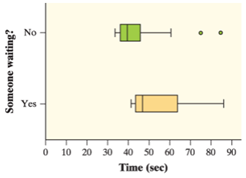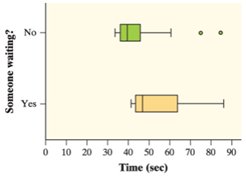
Concept explainers
(a)
To Explain: the few sentences comparing this distribution.
(a)
Explanation of Solution
Given:

People who had to wait longer, more often answered “Yes” , because the box of the box plot for ”Yes” lies greater than the box of the box plot for “No”.
The data for the “No” answered contained two outliers; the reason is that there are two dots above the box plot.
The time seems to be right-skewed, because most times take on low values (40 to 50 seconds).
The spread for the “Yes” answers is more than for the “No” an answer, the reason is that the distance between the whiskers for the “Yes” box plot is bigger.
(b)
To Explain: the conclusion which is having someone waiting causes drivers to leave their spaces more slowly.
(b)
Answer to Problem 30E
Yes
Explanation of Solution
Given:

Yes, because the box plot for when somebody was waiting (“Yes”) lies greater than the box plot for when somebody was not waiting (“No”).
This is also normal, because if there is somebody waiting then it requires taking into account the distance to the waiting vehicle. Such that you do not hit the waiting vehicle.
Chapter 5 Solutions
PRACTICE OF STATISTICS F/AP EXAM
Additional Math Textbook Solutions
Fundamentals of Statistics (5th Edition)
An Introduction to Mathematical Statistics and Its Applications (6th Edition)
STATS:DATA+MODELS-W/DVD
Basic Business Statistics, Student Value Edition
Elementary Statistics: Picturing the World (7th Edition)
 MATLAB: An Introduction with ApplicationsStatisticsISBN:9781119256830Author:Amos GilatPublisher:John Wiley & Sons Inc
MATLAB: An Introduction with ApplicationsStatisticsISBN:9781119256830Author:Amos GilatPublisher:John Wiley & Sons Inc Probability and Statistics for Engineering and th...StatisticsISBN:9781305251809Author:Jay L. DevorePublisher:Cengage Learning
Probability and Statistics for Engineering and th...StatisticsISBN:9781305251809Author:Jay L. DevorePublisher:Cengage Learning Statistics for The Behavioral Sciences (MindTap C...StatisticsISBN:9781305504912Author:Frederick J Gravetter, Larry B. WallnauPublisher:Cengage Learning
Statistics for The Behavioral Sciences (MindTap C...StatisticsISBN:9781305504912Author:Frederick J Gravetter, Larry B. WallnauPublisher:Cengage Learning Elementary Statistics: Picturing the World (7th E...StatisticsISBN:9780134683416Author:Ron Larson, Betsy FarberPublisher:PEARSON
Elementary Statistics: Picturing the World (7th E...StatisticsISBN:9780134683416Author:Ron Larson, Betsy FarberPublisher:PEARSON The Basic Practice of StatisticsStatisticsISBN:9781319042578Author:David S. Moore, William I. Notz, Michael A. FlignerPublisher:W. H. Freeman
The Basic Practice of StatisticsStatisticsISBN:9781319042578Author:David S. Moore, William I. Notz, Michael A. FlignerPublisher:W. H. Freeman Introduction to the Practice of StatisticsStatisticsISBN:9781319013387Author:David S. Moore, George P. McCabe, Bruce A. CraigPublisher:W. H. Freeman
Introduction to the Practice of StatisticsStatisticsISBN:9781319013387Author:David S. Moore, George P. McCabe, Bruce A. CraigPublisher:W. H. Freeman





